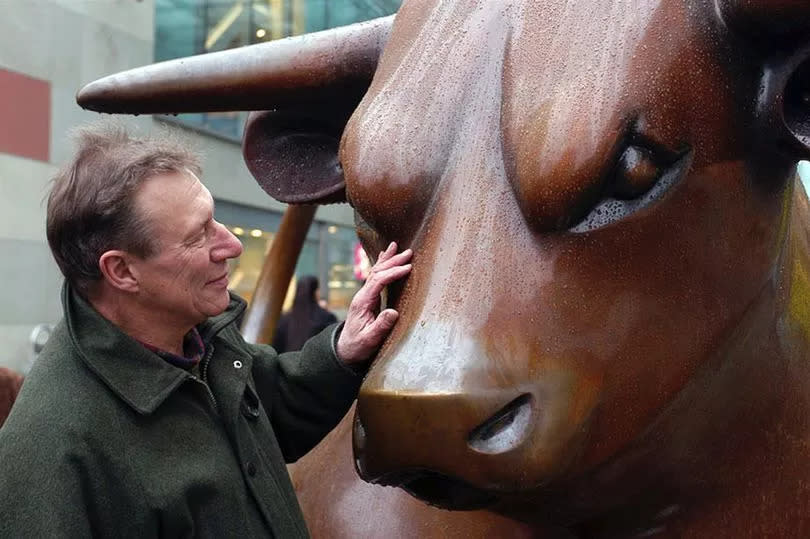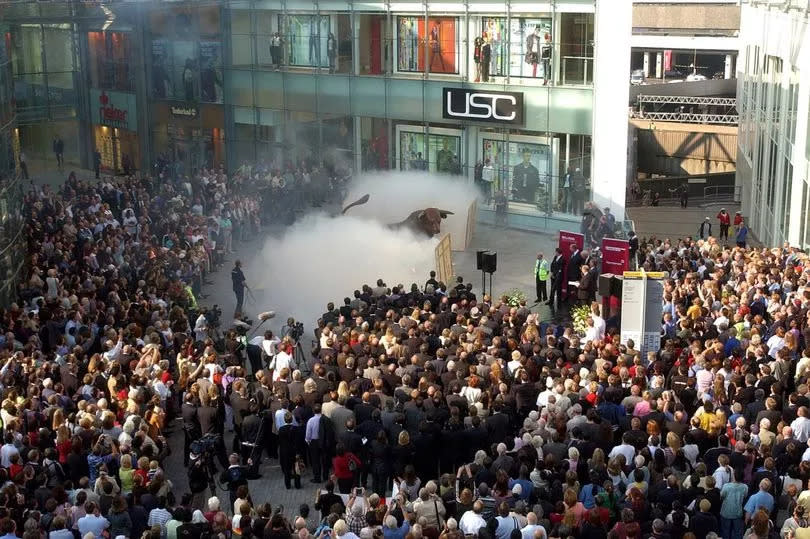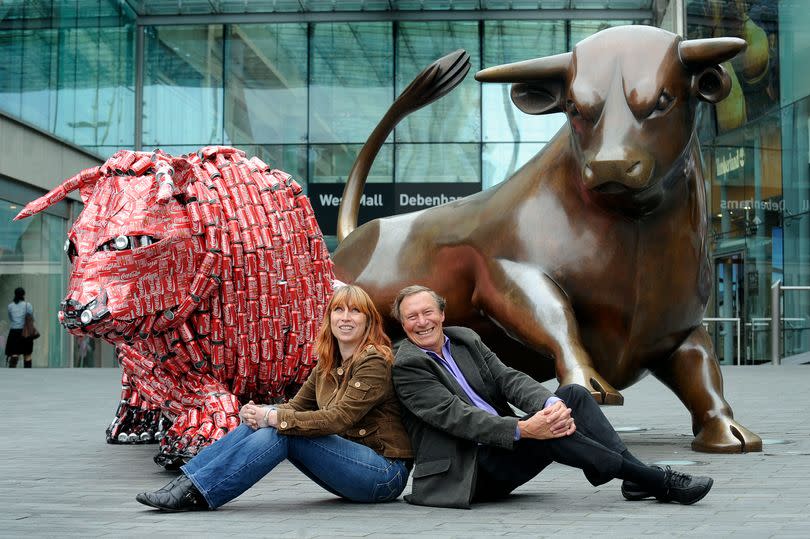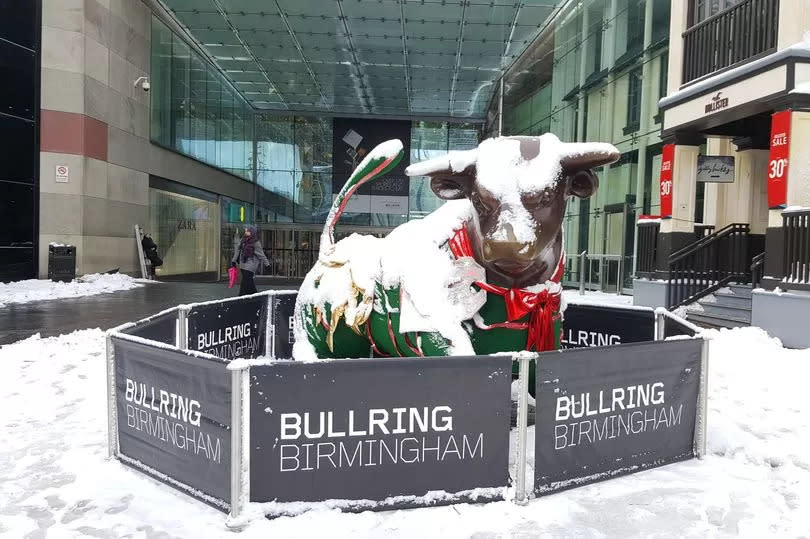Sculptor who gave Birmingham its Bullring bull dies at 88

The sculptor who created arguably Birmingham’s most iconic piece of public art has died. Laurence Broderick, who designed and created the giant bull which sits outside the entrance to the Bullring Shopping Centre, died on Thursday, April 18, aged 88.
He won a competition to create the six-tonne bronze statue, beloved by Brummies and visitors to the city, which was unveiled when the shopping centre opened on September 4, 2003. The Bristol-born artist was one of four in the running to create the artwork, which is now as much a symbol of the city as it is the neighbouring retail Mecca.
He was encouraged by Bullring developers, Hammerson, to enter the running as they ‘loved his work’ like the Leaping Salmon at Chester Business Park. His style was giving his animal sculptures movement, his son Graeham said.
READ MORE: The story behind the Bull sculpture at the Bullring shopping centre
After winning the competition, Laurence said he didn’t want to be paid for making the sculpture. But he instead asked for permission to make ‘editions’, smaller versions of the design he could sell.
He ploughed all the money for the commission, £100,000, into the bronze bull, known as The Guardian, itself, ‘making it as big as he possibly could’. The project ended up costing £130,000. But the bull at the Bullring could be no better advert for his talents.
Laurence, speaking with BirminghamLive in 2015, said: “The Bullring developers told me the bull would become very, very famous. I didn’t think about that at the time, but I agreed to do it and I went all out to make sure it was going to be a fantastic bull. The idea was to make it special - powerful and strong, everything that Birmingham is.”

Laurence researched the bull by visiting farms near his home in Waresley, Cambridgeshire. He said: "I asked farmers what exactly it was that made bulls look powerful and they said it was the shoulders.
"But every time I went to see one, they always seemed to be very static - apart from the young bulls that kept coming up to the fence and licking my pad - so I had to work on a more interesting pose for the one in the sculpture."
He drew 14 versions of the bull, selected one, made a small model and then a half-metre replica in plaster which was scaled up to make the twice life-size bull we see in Birmingham today. It has been named as one of the world’s most popular pieces of public art.
READ MORE: Birmingham's Bullring Bull declared one of the world's top public works of art
Laurence and his family used to secretly go to Birmingham and one of their favourite activities was to stand by the bull. Graeham said: “As a family a bunch of us used to go and hang around the bull and listen to people talking about it.
“My dad loved it. I think it was the greatest compliment to hear the comments. I remember many years ago someone scratched their initials into it.
“The people of Birmingham were furious with the person that did it. Whether it’s a group of lads out having a drink or young children, unlike some modern art that people either like or don’t like, when we are there with the bull people didn’t say anything bad about it.”
Laurence was born in Bristol on June 18, 1935 to Jack and Cynthia. He suffered severe asthma as a child, when there were no drugs or inhalers, and was sent to Bembridge Boarding School on the Isle of Wight, where it was hoped the sea air may help his condition.
At an early age he enjoyed drawing and knew art was what he wanted to do. He studied painting, illustration and sculpture at Regent Street Polytechnic, London, from 1952 to 1957, and Hammersmith School of Art from 1964 to 1965.
He began his artistic career as an historical and educational illustrator and painter with the BBC as well illustrating many books as a freelance artist. His particular skill was known as pen and ink drawing. He moved out of London to Waresley as it was the ‘first place when he drove north from London where he could afford a house’, Graeham said.
He taught art at the Haberdashers' Aske's School in Cricklewood from 1959 and then when the school moved to Elstree from 1961. He was director of art there from 1965 to 1981.
Among his pupils were future Formula One world champion, Damon Hill, and acclaimed set designer, Jonathan Green. He was a popular teacher and many former pupils stayed in touch and attended his exhibitions. But it was a sculpture of an otter made from stone on the Isle of Skye in 1978 that led to a job change, fame and ultimately to Brum’s iconic bull.
READ MORE: New art trail celebrating Birmingham's iconic Bull coming to city next summer
In 1980 he returned to Skye, held a six-week ‘sold out’ show and sold sculptures and made as much money from the sales as he did from a year of teaching, So he retired from his teaching role and became a full-time sculptor.
“He was incredibly passionate about sculpture”, his son said. “He didn’t consider it work. It was irrelevant if he made money out of it.” There are more than 3,000 of his sculptures around the world.
Becoming famous for his work in his 50s in his second career, his love of otters also led to him becoming joint president of the International Otter Survival Fund.

Graeham, 58, said the outpouring of tributes to his dad had been ‘absolutely incredible’. He said: “He was really known for endangered species of wildlife. He was gifted in so many areas – as an illustrator for the BBC and in children’s books, pictures, paintings, drawings in pen and ink.
“And busts and portraits of people – he did around 100 in his lifetime. It was a real talent of his, he was offered a job at Madame Tussauds in London as his sculptures were so lifelike.
“As kids we were very excited. But we lived in the countryside at the time in Waresley and it wasn’t what he wanted. He was an teacher for over 20 years, and head of department and we have had so many tributes from people he taught.
“They were inspired by him. My father had said to his pupils: 'You don’t have to be a painter or sculptor but be creative'.”

Outside of art, Laurence met Ingrid Christa Bohne, from East Germany, in 1959 while she worked as a nanny in London. They married in 1963 and had three sons. Ingrid developed Alzheimer’s in 2016 and his youngest son, Oliver, died in 2019 at the age of 46, having had multiple health issues since birth.
Those events had a ‘devastating effect’ on his life, Graeham said. He would visit Ingrid in a care home as often as possible. He also enjoyed spending time with his other two sons and four grandchildren. Graeham said: “We were very close as a family for the last couple of years.” He added: “Dad was an incredibly positive happy person. He made friends wherever he went.”
While unable to sculpt in his latter years Laurence continued to draw ‘prolifically’. But it is the bull at the Bullring which Brummies and the world will remember him for.

 Yahoo News
Yahoo News 
